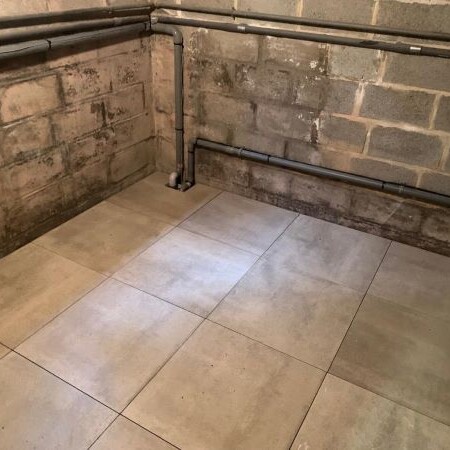The basement is often the most humid place in the entire house. This space is usually located completely underground so this room is surrounded by soil moisture, and in addition, it is not obvious to properly ventilate a basement. As a result, all sorts of moisture problems can occur. If the problem persists for a long time, it can cause permanent damage to the structural elements of your home. Obviously, this is something you want to avoid.
It is therefore of great importance that you waterproof your basement. By doing so, you will not only create an additional more pleasant living space in your home, but also significantly increase the value of your home.
What are the symptoms of a damp basement?
First, it is important to determine if you are suffering from a damp basement. Several indications can point to basement moisture problems:
- There are damp spots on the walls or puddles on the basement floor. Salt circles or mold spots may also appear.
- The stuff in your basement is damaged.
- There is a musty smell.
A damp basement is not only unpleasant, it's anything but healthy. But there is a solution: have your basement waterproofed!
The causes of a damp basement
It is very important to have a specialist look at your basement. This is because there are two different diagnoses, each requiring a specific solution to waterproof your basement. Without expertise, it is difficult to determine which diagnosis is applicable.
1. A damp basement reasons other than infiltration
Is there no infiltrating moisture from outside, but you still have a moisture problem? Then condensation moisture from lack of ventilation is probably the big culprit. With a ventilation system and special basement paint, this is quickly solved. A leak in the pipes can also cause you to struggle with a wet basement.
2. A damp basement due to infiltration
If the cause of your wet basement is infiltrating moisture, then you will likely receive one of the following three common diagnoses:
- Permeable moisture occurs when external walls are no longer able to keep moisture out, especially during rainy periods. This problem can become severe, even penetrating interior walls, and can lead to freezing and cracking in winter.
- Another cause is groundwater, which can enter the basement due to a poor foundation or cracks in the walls.
- Finally, bagged or seeping water can sink down through the walls. This happens especially after heavy precipitation.
Only a specialist can say with certainty whether it is infiltrating moisture. Usually the solution here is to waterproof your basement. But how does such basement waterproofing work? There are two options for that.

Waterproofing your basement: the methods
Depending on the cause and situation, there are several methods to waterproof your basement.
Want to get rid of your damp basement for good? Then consult a specialist in moisture control. This professional is able to identify the exact cause of the problem and can recommend and implement the most appropriate solution.
Waterproofing the basement with the classic lining
In the moisture control world, the classic method of waterproofing basement walls is known as "basement waterproofing. In this approach, basement walls are waterproofed by cementing them. The basement waterproofing process involves several steps, including the application of fixing layers, quick cement and hydraulic waterproofing mortars. We summarize:
- First, moisture experts accurately assess the specific cause, extent of the moisture problem and groundwater pressure. To do this, the existing cladding is thoroughly removed to make the substrate clearly visible. This analysis provides an opportunity to estimate what solution is required.
- A waterproof plaster is then applied in several layers to both the basement walls and the floor.
- When fully cured, these layers combine to form a strong and moisture-resistant barrier.
- This waterproof layer prevents rainwater or soil moisture from seeping in.
Waterproofing the basement with basement drainage
In a conventional basement drainage procedure using the traditional method, a pump house is embedded in the floor to collect water, followed by the application of bubble wrap. This proceeds as follows:
- The bubble liner contains a specific structure of small channels. These channels serve as a means of collecting groundwater and directing it to a central drainage pit. This drain pit is strategically placed at the lowest point of the basement.
- A water pump then pumps the water out of the collector through a drain, often equipped with sensors for automatic operation.
- Finally, the moisture expert applies a new concrete layer on top of the studded membrane. By efficiently draining groundwater under this new floor, floor drainage is a sustainable solution that also remains invisible.
Waterproof the basement with AquaConsult's unique process.
Finally, AquaConsult offers a unique method of waterproofing a basement. Again, we place a pump house in the floor where the water is collected and after several measurements, we adjust the floor with a laser. Then we install certified ceramic tiles that measure 60 x 60 x 2 inches. What's nice? You can choose the color of the tiles yourself.
There are three major advantages to this method of basement waterproofing:
- First of all, you lose less height than with the classic casing. Here we are talking about a maximum of 5 centimeters, whereas with the casing you easily lose 8 centimeters.
- It is also much more stylish. This is certainly interesting if you want to turn your basement into a real living space.
- The final advantage is the price: the cost of a classic casing is quite a bit higher than that of ceramic tiles.

Are you suffering from a damp basement? Contact the experts at Aquaconsult now for a free moisture assessment and we will be happy to help you.

